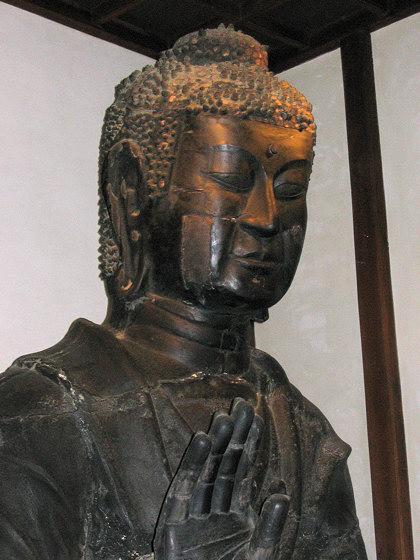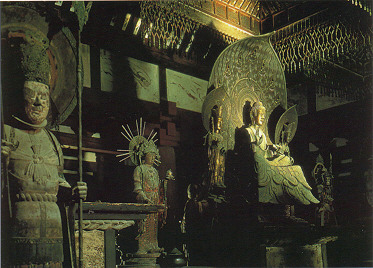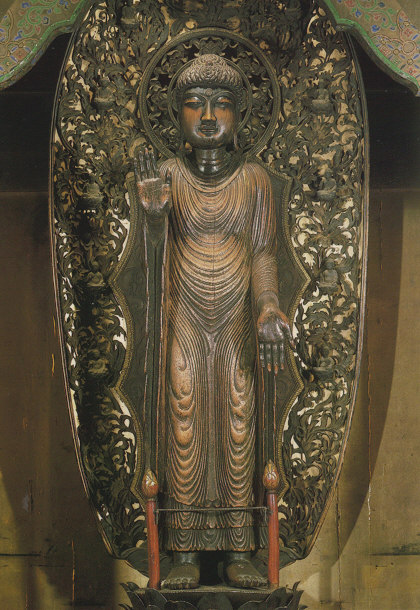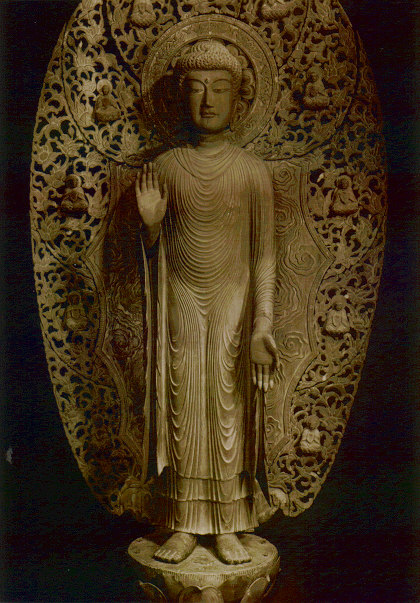Shakyamuni - the historical Buddha
Shakyamuni (Sakyamuni) is the name given to the historical Buddha. In Japan he is known as Shakuson, or more commonly Shaka or Shaka Nyorai, meaning "the Buddha."

Asuka-dera Daibutsu - the oldest image in Japan.
In the Suma chapter of The Tale of Genji the hero is seen one evening on a veranda looking out over the sea chanting: "I, a disciple of the Buddha Shakyamuni...".
In 538 the very first Buddha image to arrive in Japan was a statue of Shakyamuni presented as a gift by a Korean king. Perhaps that's why in the Asuka period, Shaka was one of the principal objects of reverence. Images at that time were usually seated and had two attendants, Fugen and Monju.
The most well-known of those early images still in existence are the Asuka Temple Great Buddha (the oldest positively dated image in Japan) and the Shaka Triad at Horyuji Temple. The 4.8m bronze Great Buddha looks rather austere now, after extensive damage caused by fire, earthquakes and bad restoration work. The Horyuji Triad is in better condition but has a rather angular appearance, having been influenced by a similar image carved in stone in northern China.

Horyuji Shaka Triad cast in bronze.
However, it seems Shaka wasn't of particular interest in Japan for several hundred years. Yakushi (the Healing Buddha) was extremely popular in the Nara period. In 985 the monk Chonen went to China on pilgrimage to China and commissioned a copy of the legendary Udayana Buddha. As the story goes, King Udayana had a sculpture of Shakyamuni made from sandalwood during the Buddha's lifetime, which was worshipped in India for 1280 years and then taken over the Himalayas to China.
Records show that the image was moved from temple to temple for various reasons and finally lost in the upheaval surrounding the Boxer Rebellion in 1900. A stone carving of the Udayana Buddha was made by order of Emperor Taiding in the 14th Century, and remains in Jiufeng Temple in China today. Chonen brought his copy back and installed it in Seiryoji Temple in northwest Kyoto but it failed to arouse much interest until the mid-13th century.

The Seiryo-ji Shaka, a copy of the lost Udayana Buddha.
Ritsu (or Risshu) - meaning "Vinaya" (the Buddhist monastic code) - one of the original six sects of Nara had long since gone into decline, but in 1249 the priest Eison ordered a copy of the Seiryoji Shaka and installed it as the principal object of worship at the large Saidaiji temple in Nara. Eison's promotion of Ritsu and this Seiryoji style Shakyamuni image led to a revival of the Ritsu sect and a cult of Shakyamuni at a time when other new sects like Pure Land and Nichiren were popular with the masses.

The Seiryo-ji style Shaka image at Saidaiji temple.
Many copies were made and new temples built in this Saidaiji lineage. Although the cult wasn't a major one, these images are the ones existing in temples around Kyoto and Kamakura now. The dynamic walking style (one hand in the "come and see" mudra, the other in the teaching mudra) of the image may have appealed to the masses as Shakyamuni was seen as the one who spread the teachings, even if he couldn't grant wishes or help one reach the Pure Land paradise as Kannon or Amida were believed to.
The Seiryoji Shaka is still shown on the 8th of each month. A nearby temple (Nison-in) has a "twin image" of Shaka and Amida, representing the teaching that Shaka enlightens you in this world and Amida saves you in the next. There is also a smaller Seiryoji style image at Saimyoji in the mountains to the northwest.
Shakyamuni is still venerated in Japan by the Zen sects, the small Ritsu sect and the much larger Nichiren sect.
For general information on Shakyamuni and his teachings, please see Buddhism for Beginners.